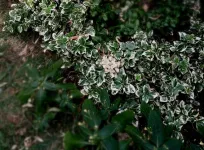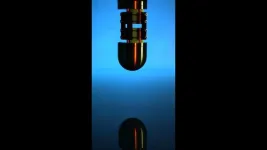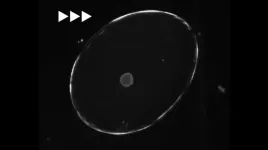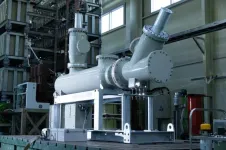(Press-News.org) Humans wouldn’t last long without plant mitochondria and chloroplasts. These essential compartments of plant cells famously capture sunlight and power plant life – and so, ultimately, provide all the food we eat.But there’s a problem: Mitochondria and chloroplasts store instructions for their building blocks in their own ”organelle” DNA or oDNA – and this can get mutated.
You can see mild effects of this in some “variegated” plants – where leaves get bleached and lose the ability to photosynthesise (see photo). Pretty in your garden, but no good for crops.
How do plants avoid the buildup of mutational damage over time?
A collaboration between the University of Bergen and Colorado State University has shed new light on this question.
Perhaps surprisingly, the answer is – in part – by exploiting randomness.
Generating diversity with randomness
If a plant inherits some amount of mutation from its mother, and passes the same amount of mutation on to each of its offspring, mutations will inevitably build up over generations and the plant’s descendants will die off. Instead, plants spread out the damage they inherit, so that while some offspring unfortunately inherit lots of mutations, others inherit far fewer. This process – which also happens in animals (including humans) – is called segregation. And it relies on the plant generating random differences between its offspring.
“The segregation process is known to be very fast in humans, and has a big effect on the inheritance of human genetic diseases,” said Dan Sloan, the head of the Colorado research team. “Remarkably, we’ve found that it’s even faster in plants.”
Agricultural implications
“Our work is really exciting because until now we had very little information about how these mutations behave in plants,” added Amanda Broz, first author on the study. “Agricultural scientists have recently become interested in understanding variation in oDNA because mitochondria and chloroplasts are so critically essential to plant growth and yield – our results are good news for crop breeders wanting to introduce new beneficial mutations.”
To understand the segregation of oDNA, the team generated plants which inherited high levels of mutations, and tracked how these mutations were distributed through the plant over time. They then used mathematical and statistical modelling to translate these experimental observations into theory describing how the plant was randomly spreading out its inherited damage. They found that a combination of processes – random distribution of oDNA when cells divide, and random overwriting of some oDNA molecules with others – could explain all their observations of plant segregation over time and from mothers to daughters. They also found some support for the idea that plants “set aside” some cells early in their lives that will end up responsible for producing the next generation – an idea currently actively debated in plant science.
“I’ve dreamed for years of exploring this process,” said Iain Johnston, corresponding author and leader of the Bergen research team. “It’s the combination of these beautiful new plant lines, detailed experiments, and modern maths and statistics that has made it possible.”
The team’s results support recent theories about how many other lifeforms maintain their power plants, and could be a step towards the manipulation of oDNA in plants – an important aspect of crop breeding and yield enhancement.
The research was supported by the European Research Council, National Science Foundation, and Peder Sather fund.
The results are published in New Phythologist. New Phytologist is a leading international journal focusing on high quality, original research across the broad spectrum of plant sciences, from intracellular processes through to global environmental change. The journal is owned by the New Phytologist Foundation, a not-for-profit organisation dedicated to the promotion of plant science. https://www.newphytologist.org/
END
Plants' ingenious defence against mutational damage
2023-11-06
ELSE PRESS RELEASES FROM THIS DATE:
Landmark study reveals critical shortage in UK prosthetic and orthotic workforce
2023-11-06
A Staffordshire University study has revealed a significant deficit in the number of prosthetists, orthotists, prosthetic and orthotic technicians, and support workers in the UK.
The report by the Centre for Biomechanics and Rehabilitation Technologies (CBRT) is formally launched today, 6 November 2023.
This research, commissioned by the British Association of Prosthetists and Orthotists (BAPO), found there are currently 631 orthotists and 295 prosthetists employed nationwide. However, an additional 142 to 477 prosthetists/orthotists are needed to meet World Health Organization standards of care.
"This workforce shortage is worrying," said Professor Nachi ...
At the same PSA level, Black men are more likely to have prostate cancer than white men
2023-11-06
Black men in the United States are more likely to develop prostate cancer than white men, and after diagnosis, they’re more likely to have advanced disease and to die than white men with the disease. Although it would seem that earlier prostate‐specific antigen (PSA) screening could reduce the risk of fatal prostate cancer in Black men, new research indicates that at any given PSA level, Black men are more likely to harbor prostate cancer than white men, indicating that they may face an increased risk of prostate cancer than white men at lower PSA levels. The findings are published by Wiley online in CANCER, ...
Want the secret to less painful belly flops? These researchers have the answer.
2023-11-06
PROVIDENCE, R.I. [Brown University] — Anyone who’s ever done a belly flop into a swimming pool knows it ends with a blunt-sounding splat, a big splash and a searing red sting. What most people don’t know is why.
Daniel Harris does. The assistant professor in Brown University’s School of Engineering says the physics behind the phenomenon aren’t too complex. What happens — and what makes it so painful, he explains — is that the forces from the water surface put up a fierce resistance to the body suddenly going from air to water, which is often still.
“All of a sudden, ...
Video technology could transform how scientists monitor changes in species evolution and development
2023-11-06
Scientists have made a major breakthrough in the study of species evolution, and provided further evidence that state-of-the-art visual technology can be used to track the tiniest changes in different organisms’ development.
New research used a combination of robotic video microscopes and computer vision to measure all of the observable characteristics of embryos of three different species.
These measurements were recorded as spectra of energy and, through this, scientists were able to compare shifts between species alongside previously documented differences in the timing of discrete developmental ...
KERI developed an alternative technology for ‘SF6’, the main culprit of global warming
2023-11-06
Korea Electrotechnology Research Institute (KERI) has developed a world-class 'eco-friendly insulating gas' that replaces SF6 (sulfur hexafluoride), the main cause of global warming in the field of electric power equipment, and developed a design technology to make it applicable to ultra-high voltage transmission circuit breakers.
Of course, power devices must be able to conduct electricity well but an ‘insulation’ function to block electricity is also essential to prepare for unexpected accidents and for safety reasons. SF6 gas offers excellent insulation and with far superior arc extinguishing performance than any other ...
Emergency departments saw firearm injuries in children double during pandemic
2023-11-06
Pediatric Emergency Department (ED) visits for firearm injuries doubled during the pandemic compared to earlier trends, according to a multicenter study published in the journal Pediatrics. During this time, deaths from firearm injuries in children and adolescents that occurred after arrival to the hospital also doubled – up from 3 percent of ED visits pre-pandemic to 6 percent of ED visits during the pandemic.
“With the pandemic we saw a drastic increase in firearm purchases, which might have led to the tragic spikes in injuries and deaths from firearms among children ...
High biological age may increase the risk of dementia and stroke
2023-11-06
People who have a higher biological age than their actual chronological age have a significantly increased risk of stroke and dementia, especially vascular dementia. These are the results of a study from Karolinska Institutet in Sweden published in the Journal of Neurology, Neurosurgery and Psychiatry.
The study, which was led by Sara Hägg, associate professor, and Jonathan Mak, doctoral student at the Department of Medical Epidemiology and Biostatistics, Karolinska Institutet, shows that the increased risk persists even if other risk factors such as genetics, lifestyle and socioeconomics are taken into account.
As we age, the risk of chronic diseases such as ...
New research shows quasars can be buried in their host galaxies
2023-11-06
-With pictures-
A new study reveals that supermassive black holes at the centres of galaxies, known as quasars, can sometimes be obscured by dense clouds of gas and dust in their host galaxies.
This challenges the prevailing idea that quasars are only obscured by donut-shaped rings of dust in the close vicinity of the black hole.
Quasars are extremely bright objects powered by black holes gorging on surrounding material.
Their powerful radiation can be blocked if thick clouds come between us and the quasar.
Astronomers have long thought this obscuring material only exists in the quasar's immediate surroundings, in a "dusty torus" (or donut) encircling it.
Now, a team of ...
EMBARGOED: Bendy X-ray detectors could revolutionize cancer treatment
2023-11-06
EMBARGOED: 0001 GMT MONDAY 6 NOVEMBER 2023
New materials developed at the University of Surrey could pave the way for a new generation of flexible X-ray detectors, with potential applications ranging from cancer treatment to better airport scanners.
Traditionally, X-ray detectors are made of heavy, rigid material such as silicon or germanium. New, flexible detectors are cheaper and can be shaped around the objects that need to be scanned, improving accuracy when screening patients and reducing risk when imaging tumours and administering radiotherapy.
Dr Prabodhi Nanayakkara, ...
Real-world analysis of sodium-glucose cotransporter-2 inhibitors in kidney transplant recipients
2023-11-04
Highlights
Compared with kidney transplant recipients who did not receive sodium-glucose cotransporter-2 inhibitors, those treated with the medications had lower risks of experiencing kidney transplant failure, kidney transplant rejection, major adverse cardiac events, all-cause mortality, and genitourinary infections.
Results from the study will be presented at ASN Kidney Week 2023 November 1–November 5.
Philadelphia, PA (November 4, 2023) — Sodium-glucose cotransporter-2 (SGLT2) inhibitors lower blood sugar levels and have additional beneficial effects on kidney and heart health for individuals with ...





